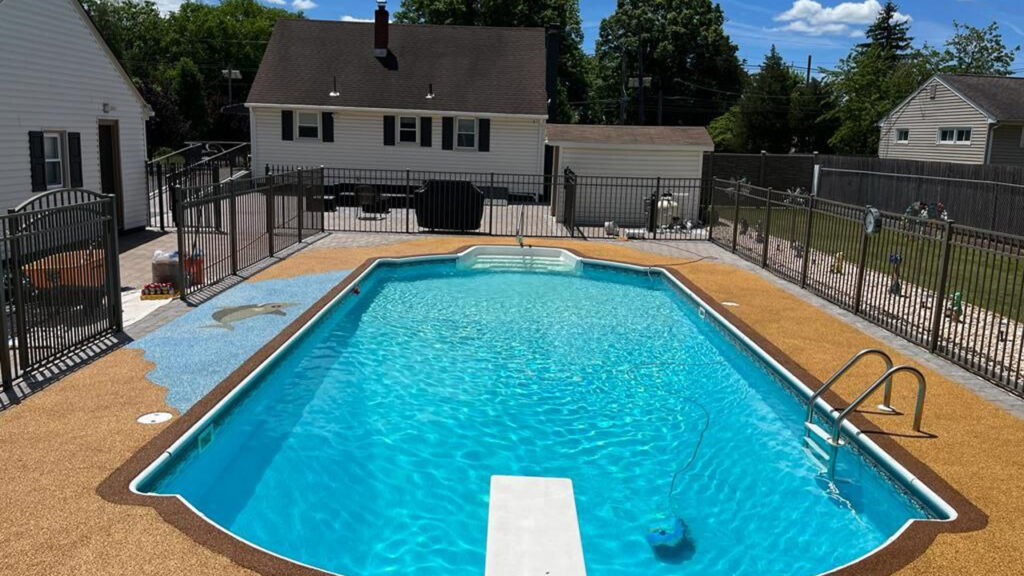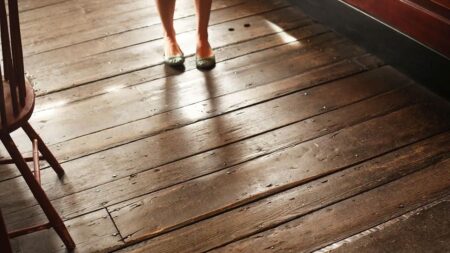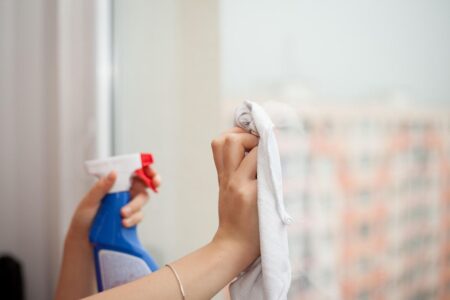You probably chose rubber for your pool deck because it is soft, does not skid, and prevents your feet from heat on hot summer days. But like any other surface outside, it gets older with time. You might see some places fading, little fractures appearing, or some regions harsher than they used to be. The fix? Resurfacing. Done right, it brings back the clean look and soft feel without ripping up the whole thing.
What is Rubber Pool Deck Resurfacing?
Resurfacing rubber pool deck is a process where you cover your existing pool deck, usually made of concrete, with a layer of rubber mixed with special resins. This creates a smooth, non-slip, and soft surface that is strong and safe for use around pools.
Key Benefits of Rubber Pool Deck Resurfacing
Enhanced Safety
Rubber surfacing around your pool creates a slip-resistant area, even when it is wet. This way, you make your pool deck safer, especially for children and the elderly. Furthermore, if someone falls, the cushioning effect of the rubber helps to absorb the impact.
Comfort and Cooling
Unlike traditional materials like concrete or stone that retain heat, rubber pool deck surfacing is the best choice for hotter climates as rubber is a heat-resistant material that stays cool underfoot, even in direct sunlight. Its cushioned surface is more comfortable for walking and standing with bare feet.
Durability and Longevity
Rubber pool decking is considered durable due to its inherent flexibility, which allows it to withstand temperature fluctuations without cracking or fading. It is believed to last for 10-15 years, and even longer with proper maintenance.
Low Maintenance
Cleaning a rubberized pool deck is easy; all you need to do is remove all the debris regularly and sweep or rinse with water, and you may use mild soap and a brush for stain removal sometimes. Inspect the surface frequently and take action accordingly if you find any cracks or mold signs.
Versatility
Rubber surfacing is available in a wide variety of colors and patterns, which means you can decide the look of your poolside in your desired way. You can create a pool deck that seamlessly complements your existing outdoor decor or go for something that shows your taste.
Environmentally Friendly
Rubber pool deck surfaces offer several environmental advantages, such as a lower carbon footprint, durability, and recyclability. Many products are also utilizing recycled materials, such as tires, which reduces landfill waste in order to contribute to sustainability.
Cost-Effectiveness
Rubber pool decking might cost a bit more to install at first than some other materials. But because it lasts a long time and needs little maintenance, it can save money over time.
Installation Methods
- Poured-in-place systems: This method involves mixing rubber granules with a binder and troweling them onto the prepared surface
- Rubber tile flooring: As the name suggests, it is a kind of tile that is readily available in the market. It can also be installed in a DIY-friendly approach
Also Read: 5 Best Robotic Pool Cleaners of 2025 are Solar-Powered, AI-Enabled, and Smarter Than Ever
Tips to Resurface Your Rubber Pool Deck
If you are considering resurfacing your rubber pool deck, it is great to know what you are getting into before you start calling around or picking up a roller. Below are a few straightforward tips and tricks that will help you complete the job smoothly.
Start With a Good Look
Do not rush this part. Walk around your pool, barefoot if you are comfortable. Feel the surface, not just visually but physically. You will know where it’s worn. Watch for:
- Areas where color has faded or turned blotchy
- Cracks, even hairline ones, especially near the edges
- Rubber lifting at corners or seams
- Slick spots where the grip’s worn off
- Standing water where there didn’t used to be any
Some of these are cosmetic. Others hint at deeper problems with drainage or prep. Either way, the first step is understanding what needs fixing.
Cleaning: More Important Than You Think
Rubber might feel soft underfoot, but sunscreen, body oils, and pollen build up on the surface over time. Before you resurface anything, you will need to give it a proper clean. Not just a quick rinse.
Use a deck brush and a cleaner designed for outdoor rubber surfaces. You can also use a pressure washer, but do not overdo it, as too much pressure can damage the top layer. Let the surface dry completely. That part is non-negotiable as dampness beneath a fresh coat will mess with the bond.
When Edges Lift, Don’t Just Patch Over Them
If the rubber surface is lifting near a drain or the edge, do not just smooth it over and call it done. Lifted spots usually mean moisture snuck under the surface, or the binder gave out. Either way, those areas need cutting back and rebonding before you move forward.
Same goes for the bubbles. You need to pop them, cut out the nasty stuff, and put them back together with a new mix. Covering up the issue only pushes it down the road and makes future repairs harder.
Match Materials – or Know What You’re Replacing
All rubber surfacing products are different, and thus, they might not match with each other properly. If your deck was installed years ago, the color, granule size, or even the binder used might not be available now. That does not mean you cannot resurface – it just means you might need to refresh the entire area if matching matters.
Sometimes, a slightly different shade blended in around steps or ladders will not be obvious. But if you are doing large sections, ask your supplier if they can match the original mix or come closer.
Time it Right: Weather Matters
When resurfacing your rubber pool deck, you would need a dry spell, with bright skies and pleasant temperatures for two or three days. If it is too hot, the binder can set before you are done smoothing. If it is too chilly or humid, it can stay tacky for too long.
In early spring and early fall, most areas are at their best. It is fine to work in the summer, but organize your work around the warmest hours of the day. And don’t be fooled by a dry forecast. A late-day thunderstorm can ruin an uncured surface in minutes.
Mixing: Steady and Even Wins
If you are tackling this as a DIY project, take your time with the mix. The ratio of rubber to binder matters. Too wet, and it will slump or bleed. It will not level right if it is too dry. Most kits come with instructions. Follow them, but do not be afraid to try a little patch first.
If you are working with multiple batches, mix them consistently. Color and texture can shift between batches if the ratio is off even slightly. It is the kind of detail a professional notices early, and a homeowner will, too, after the sun hits it for a week.
Work in Sections and Blend Carefully
Troweling rubber surfacing is part skill, part rhythm. You will want to work in sections small enough to finish while the mix is still workable. Overlap slightly with each pass so seams are not visible.
Edges and curves are trickier, so plan extra time for these. Use a smaller trowel or even a rounded float to get into tight spots. Do not rush corners because that is where mistakes usually happen.
If you are resurfacing over old rubber, feather the new material into the existing surface rather than building a sharp line. You will be able to see even a quarter-inch ridge once it dries.
Add a Topcoat? Depends on the Surface
Some rubber resurfacing systems offer topcoats, which are a sealant that restores color and adds UV resistance. Some people do not require it. A topcoat could help keep the color of your deck longer if it gets a lot of direct sunlight.
But do not depend on it too much. A topcoat will not remedy bad prep work or keep deeper problems from coming back. It is like wax on a car; it helps, but only if the base is strong.
Aftercare Makes Big Difference
Once your pool deck resurfacing is done, give it at least 48 hours before starting heavy foot traffic on it. If you can, do not put furniture on it for a few days. And every few weeks during the season, give it a good rinse, especially if you apply oils or sunscreens near the pool.
Avoid harsh chemicals. A hose and soft bristle brush usually do the trick. If something spills, do not wait a week to deal with it; clean it up right away.
Final Word
It is not hard to resurface a rubber pool deck, but you should not do it too quickly. If you pay attention to the prep work, scheduling, and materials, you can turn a patch job into a surface that looks and feels new again.
If you are up for it, smaller touch-ups can be DIY. But for larger areas or when repairs involve peeling or base issues, it is recommended to bring in someone who knows what they’re doing. If you’re wondering where else this material works, it is great for playgrounds, too. Same comfort. Same durability. Different kinds of splash zones.
Follow Homecrux on Google News!




